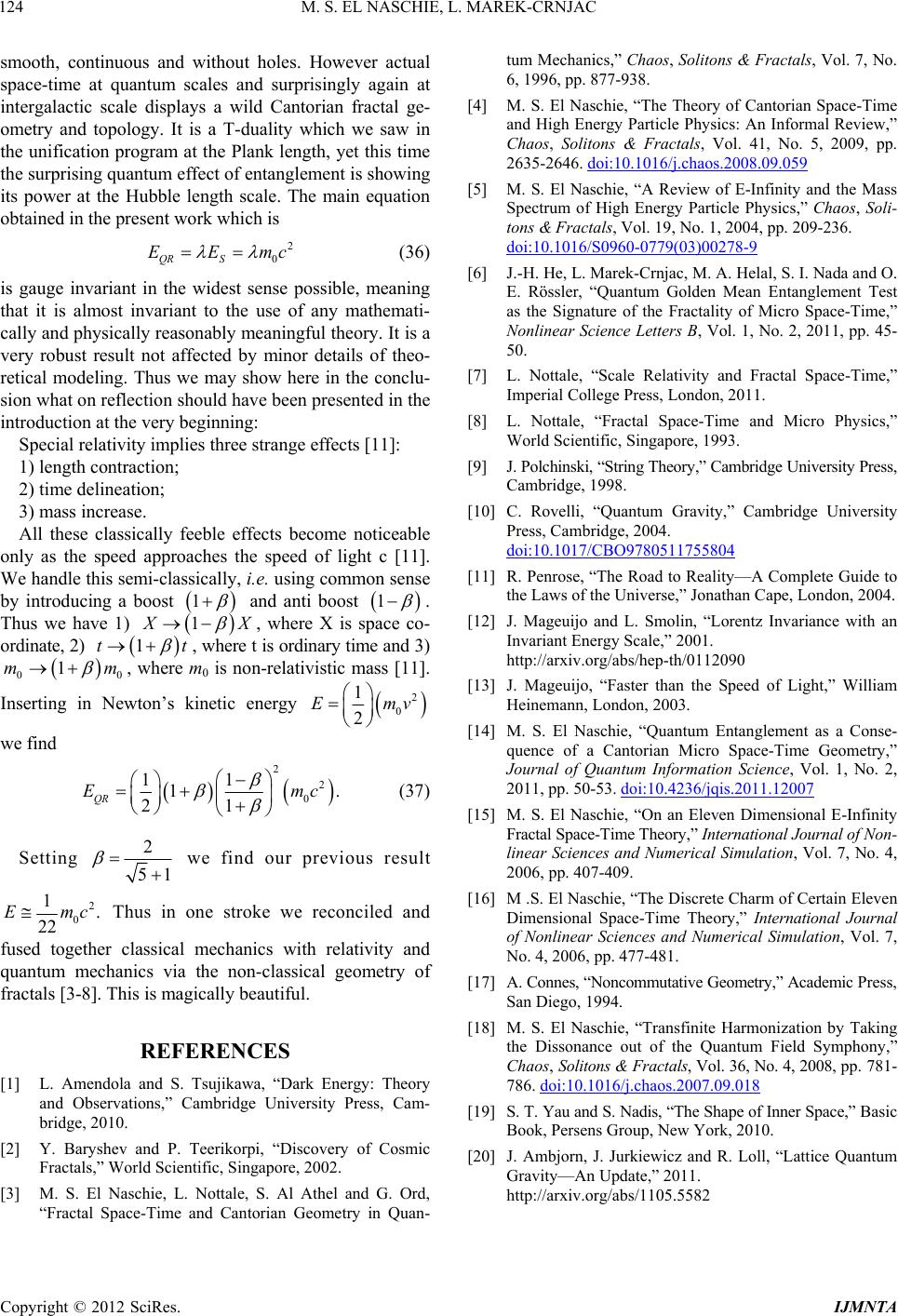
M. S. EL NASCHIE, L. MAREK-CRNJAC
Copyright © 2012 SciRes. IJMNTA
124
c
smooth, continuous and without holes. However actual
space-time at quantum scales and surprisingly again at
intergalactic scale displays a wild Cantorian fractal ge-
ometry and topology. It is a T-duality which we saw in
the unification program at the Plank length, yet this time
the surprising quantum effect of entanglement is showing
its power at the Hubble length scale. The main equation
obtained in the present work which is
2
0QR S
EEm
(36)
is gauge invariant in the widest sense possible, meaning
that it is almost invariant to the use of any mathemati-
cally and physically reasonably meaningful theory. It is a
very robust result not affected by minor details of theo-
retical modeling. Thus we may show here in the conclu-
sion what on reflection should have been presented in the
introduction at the very beginning:
Special relativity implies three strange effects [11]:
1) length contraction;
2) time delineation;
3) mass increase.
All these classically feeble effects become noticeable
only as the speed approaches the speed of light c [11].
We handle this semi-classically, i.e. using common sense
by introducing a boost
1
and anti boost
1
.
Thus we have 1)
1
X
t
, where X is space co-
ordinate, 2)
1t
0
m
, where t is ordinary time and 3)
, where m0 is non-relativistic mass [11].
0
1m
Inserting in Newton’s kinetic energy
2
0
1
2
Emv
we find
2
2
0
11
1.
21
QR
Em
c (37)
Setting 2
51
we find our previous result
2
0
1.
22
Emc Thus in one stroke we reconciled and
fused together classical mechanics with relativity and
quantum mechanics via the non-classical geometry of
fractals [3-8]. This is magically beautiful.
REFERENCES
[1] L. Amendola and S. Tsujikawa, “Dark Energy: Theory
and Observations,” Cambridge University Press, Cam-
bridge, 2010.
[2] Y. Baryshev and P. Teerikorpi, “Discovery of Cosmic
Fractals,” World Scientific, Singapore, 2002.
[3] M. S. El Naschie, L. Nottale, S. Al Athel and G. Ord,
“Fractal Space-Time and Cantorian Geometry in Quan-
tum Mechanics,” Chaos, Solitons & Fractals, Vol. 7, No.
6, 1996, pp. 877-938.
[4] M. S. El Naschie, “The Theory of Cantorian Space-Time
and High Energy Particle Physics: An Informal Review,”
Chaos, Solitons & Fractals, Vol. 41, No. 5, 2009, pp.
2635-2646. doi:10.1016/j.chaos.2008.09.059
[5] M. S. El Naschie, “A Review of E-Infinity and the Mass
Spectrum of High Energy Particle Physics,” Chaos, Soli-
tons & Fractals, Vol. 19, No. 1, 2004, pp. 209-236.
doi:10.1016/S0960-0779(03)00278-9
[6] J.-H. He, L. Marek-Crnjac, M. A. Helal, S. I. Nada and O.
E. Rössler, “Quantum Golden Mean Entanglement Test
as the Signature of the Fractality of Micro Space-Time,”
Nonlinear Science Letters B, Vol. 1, No. 2, 2011, pp. 45-
50.
[7] L. Nottale, “Scale Relativity and Fractal Space-Time,”
Imperial College Press, London, 2011.
[8] L. Nottale, “Fractal Space-Time and Micro Physics,”
World Scientific, Singapore, 1993.
[9] J. Polchinski, “String Theory,” Cambridge University Press,
Cambridge, 1998.
[10] C. Rovelli, “Quantum Gravity,” Cambridge University
Press, Cambridge, 2004.
doi:10.1017/CBO9780511755804
[11] R. Penrose, “The Road to Reality—A Complete Guide to
the Laws of the Universe,” Jonathan Cape, London, 2004.
[12] J. Mageuijo and L. Smolin, “Lorentz Invariance with an
Invariant Energy Scale,” 2001.
http://arxiv.org/abs/hep-th/0112090
[13] J. Mageuijo, “Faster than the Speed of Light,” William
Heinemann, London, 2003.
[14] M. S. El Naschie, “Quantum Entanglement as a Conse-
quence of a Cantorian Micro Space-Time Geometry,”
Journal of Quantum Information Science, Vol. 1, No. 2,
2011, pp. 50-53. doi:10.4236/jqis.2011.12007
[15] M. S. El Naschie, “On an Eleven Dimensional E-Infinity
Fractal Space-Time Theory,” International Journal of Non -
linear Sciences and Numerical Simulation, Vol. 7, No. 4,
2006, pp. 407-409.
[16] M .S. El Naschie, “The Discrete Charm of Certain Eleven
Dimensional Space-Time Theory,” International Journal
of Nonlinear Sciences and Numerical Simulation, Vol. 7,
No. 4, 2006, pp. 477-481.
[17] A. Connes, “Noncommutative Geometry,” Academic Press,
San Diego, 1994.
[18] M. S. El Naschie, “Transfinite Harmonization by Taking
the Dissonance out of the Quantum Field Symphony,”
Chaos, Solitons & Fractals, Vol. 36, No. 4, 2008, pp. 781-
786. doi:10.1016/j.chaos.2007.09.018
[19] S. T. Yau and S. Nadis, “The Shape of Inner Space,” Basic
Book, Persens Group, New York, 2010.
[20] J. Ambjorn, J. Jurkiewicz and R. Loll, “Lattice Quantum
Gravity—An Update,” 2011.
http://arxiv.org/abs/1105.5582